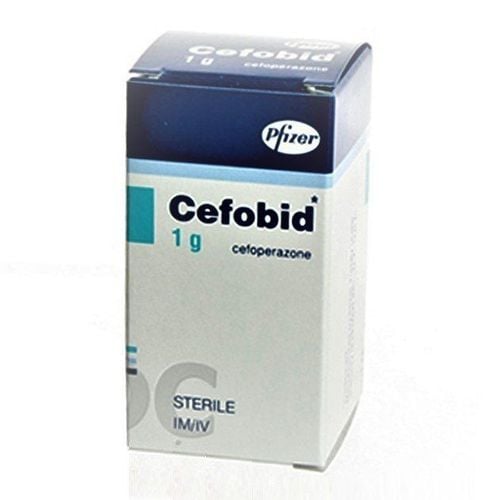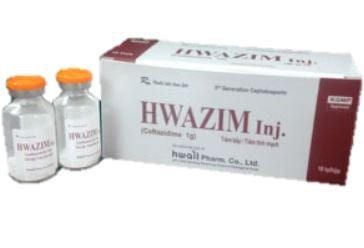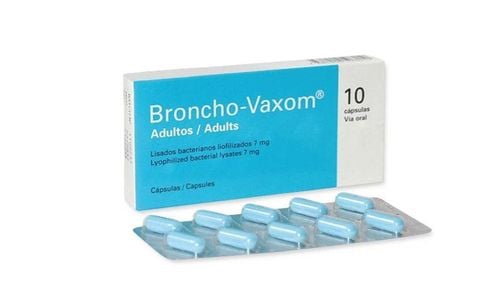This is an automatically translated article.
Fordamet contains the main ingredient Cefoperazone - a 3rd generation cephalosporin antibiotic. The drug is prepared in the form of a powder for injection, used in the treatment of a number of bacterial infections.1. What is Fordamet?
Fordamet medicine contains Cefoperazone (as Cefoperazone sodium) 1g. This is an active ingredient that has an antibacterial effect through inhibition of bacterial cell wall synthesis. The remarkable point of this ingredient is that it has a fairly broad spectrum of action, including gram-positive aerobic bacteria, gram-negative aerobic bacteria, anaerobic bacteria and many other pathogenic bacteria, ...
2. Indications and contraindications
2.1. Point
Fordamet can be used in the treatment of infections caused by bacteria sensitive to the drug, including:Patients with bone infections, pneumonia, tissue or skin infections,... Support for the treatment of genital infections in women. Fordamet is also indicated for use in post-operative infection prophylaxis for patients with abdominal surgery, orthopedic trauma, gynecological diseases...
2.2. Contraindications
Fordamet is contraindicated in patients with a history of allergy to cefoperazone and other cephalosporin antibiotics.3. Usage and dosage
Fordamet is administered by deep intramuscular injection or by intermittent intravenous infusion (about 15 - 30 minutes) or continuously with the following reference doses:3.1. Adults
For patients with mild and moderate infections, the usual dose is 1-2g, used every 12 hours.For patients with severe infections, the dose can be increased to 12g/24 hours, divided into 2-4 doses. Immunocompromised patients can receive up to 16g/day by continuous infusion.
3.2. Children
Use Fordamet for intravenous injection in children at a dose of 25-100mg/kg, every 12 hours. In which, the dose for infants is 50mg/kg every 12 hours; young children from 25-50mg/kg every 6-12 hours. However, it should be noted that the maximum dose is only 400mg/kg/day, not more than 6g/day.3.3. Other subjects
Patients with renal impairment can use Fordamet at the usual dose without dosage adjustment because the drug is mainly eliminated via the biliary tract. However, in case there are signs of drug accumulation, the patient must reduce the dose accordingly.Dosage for people with liver disease or biliary obstruction is usually not more than 4g / 24 hours. In the case of higher doses of Fordamet, patients should be monitored for plasma concentrations of cefoperazone.
4. Side effects
Some side effects that you may experience when using Fordamet include:Rash, hives on the skin. Eosinophilia, diarrhea, nausea or vomiting. Phlebitis, hypoprothrombinemia, superinfection. If you notice any side effects while taking the medicine, consult your doctor or pharmacist.
5. Fordamet drug interactions
Fordamet has the potential to interact with some of the following drugs:Concurrent use of Fordamet with aminoglycosides may increase the risk of nephrotoxicity. Concomitant use of heparin and warfarin may potentiate the prothrombin-lowering effects of Fordamet and increase the risk of bleeding. When using Fordamet concomitantly with hepatotoxic drugs, the patient should be monitored for liver function. Fordamet may decrease the effectiveness of typhoid vaccine as well as cause false positive results in urine glucose tests. Do not drink alcohol while taking the drug because the patient may experience symptoms such as sweating, headache, nausea, vomiting, tachycardia,... In order to use the drug safely and effectively, the patient should be informed. Tell your doctor about your medical history and any medications and supplements you are taking. If there are any unusual symptoms, the patient should immediately notify the doctor for the best advice and support.
6. Precautions when using Fordamet
In the process of using Fordamet, patients should note the following issues:Use the drug with caution because there are cases of recorded hypersensitivity cross-reactions (including anaphylaxis) in some patients. allergic to beta-lactam antibiotics. Use of Fordamet for long-term treatment of diseases carries a risk of developing non-susceptible strains of bacteria. Therefore, in case of superinfection, the patient needs to stop taking the drug. Use caution when using Fordamet in pregnant women, preferably only when absolutely necessary (as prescribed by a doctor). Although the active ingredient Cefoperazone in Fordamet is excreted in human milk at low concentrations (about 0.4 - 0.9 micrograms/ml after a dose of 1g infusion). However, caution should still be exercised when giving the drug to a nursing mother, especially in the case of young children who are suffering from problems such as diarrhea, thrush and rashes. The drug can be used for drivers, operating machinery because it does not affect the nervous system. Thus, you have just learned some basic information about the drug Fordamet. However, this information is for reference only and is not a substitute for medical diagnosis or treatment. Therefore, you need to take Fordamet exactly as prescribed by your doctor.
Please dial HOTLINE for more information or register for an appointment HERE. Download MyVinmec app to make appointments faster and to manage your bookings easily.













